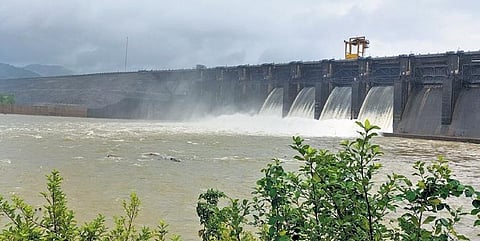

KARWAR: The state government’s Gruha Jyothi scheme, where 200 units of power are doled out free, may face a lot of difficulties and could also financially burden the state further as hydel power generation, which is a major contributor to the state grid especially during monsoon, has hit a low.
This is because of scanty rainfall since the onset of monsoon in June. Officials at the Karnataka Power Corporation Ltd (KPCL) said the situation is quite grim as hydel power generation units can produce power for only the next four months.
The state has an installed capacity of over 11,000 MW from both conventional and non-conventional sources, but is producing little over 4,000 MW now. The present water levels in reservoirs can generate peak load for another 110 days as hydel power reservoirs in the state are not even half full. The Linganamakki dam, which has the capacity to generate 1,035 MW from its 10 units, is producing an average of only 453 MW now. Varahi or Mani dam which generates up to 900 MW with its three units now produces 230 MW. Shivanasamudra, the first power station in the country, with a capacity of 42 MW is generating 20 MW.
All the hydel power generating stations along the Kali River are producing negligible power. Supa, which has a huge catchment area as it is close to the Western Ghats, has 2 units of 540 MW each. As the reservoir is situated at an altitude, water is utilised and let out into the river. It is stored downstream at Nagjhari near Dandeli. “Here, five units generate 150 MW of power.
The water is utilised and released into Bommanahalli reservoir, where the water is stored and released into Kodasalli dam, which is 71 metres high and is below sea level. There, we have five units, each capable of generating 40 MW of power. Kadra is the last dam that is also below sea level with three units with a generating capacity of 50 MW each. But we are producing only half of its capacity,” a KPCL official told TNIE.
As per the latest report, Nagjhari can produce less than 500 MW of power and Kodasalli 34 MW, while Kadra with a capacity of 150 MW is yet to resume operations.
As of now, the state is drawing power from solar stations and purchasing it from private players. The Udupi Power Corporation Ltd through its solar sources contributes 2 million units every day, while one million units are purchased from Jindal. Nearly 21 million units of solar power are being purchased at Rs 10 per unit.
Thermal power is the other important option before the state government, but the lack of dedicated coal supplies has affected production at the state-owned Ballari, Raichur and Yermaraus power plants.
Sources said that the Centre has instructed the state government to import cheap coal from other countries to meet the power requirement. As of Monday, September 4, the state consumed 223.19 mu of power. Only a good spell of rain can salvage the situation and avoid load shedding, especially in Bengaluru.